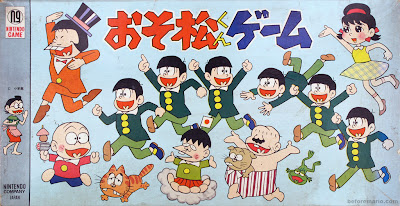Foremost, it should have eye-popping box art that depicts the gameplay joys that will be provided by the toy or game. But also important is a recognized brand that assures quality and provides reason for the customer-to-be to believe that this promise, made by the image on the front, will be delivered.
 |
| Nintendo's 'grey band' games (1966-67) |
In order for a brand to be recognized, a signature box design helps a lot; a standardized format by which the toymaker can be identified in an instant, by a mere glance at the box.
Nintendo introduced such a signature design around 1966. The design's main feature was a grey band on the left side of the box.
This grey band includes a 'Nintendo Game' logo on the top, and a 'Nintendo Company Japan' mark on the bottom.
Nintendo borrowed this box design of Milton Bradley (MB), the American game company (founded in 1860!) from which they licensed some games for release in Japan, including Twister and Skill-it.
 |
| MB's The Game of Life (1960) |
It is likely that the first Nintendo games with the grey band where the rebranded licensed MB games. However, Nintendo expanded the use of this design to all their games in this period, including many original Nintendo games, as well as for licenses from other companies.
Below an overview is presented of (almost all of) the games that Nintendo released with the 'grey band'.
Let's start with two different Ultraman games, both imaginatively called Ultraman Game (ウルトラマンゲーム). [More information about these games can be found here.]
Captain Ultra Coaster (キャプテン ウルトラ コースター) and Ultra Coaster Game (ウルトラ コースター ゲーム). [More info here.]
Five board games; UltraQ Game (ウルトラQゲーム), Obake no Qtarou Game (オバケのQ太郎ゲーム), Naruheso-kun Game (なるへそくんゲーム), Sutoppu! niichan Game (ストップ!にいちゃんゲーム) and Osomatsu-kun Game (おそ松くんゲーム). [More info here.]
Car racing game Indianapollis (note: one 'l' too many).
The first Japanese release of the evergreen Twister (ツィスターゲーム), licensed by Nintendo from MB.
Another game licensed from MB: Marble (マーブル).
Nintendo's first blockbuster: Ultra Hand (ウルトラ ハンド). [More info here.]
Bikkuri Game (びっくりゲーム).
Construction kits Picture Cutter and New Picture Cutter (ピクチャー カッター, ニュー ピクチャー カッター). [More info here.]
The name says it all: Balance Game (バランスゲーム).
And concluding: three roulette sets. The first is called Magic Roulette (マジックルーレット) and the others simply Roulette. These last two are the odd ones out, as they actually do not use the grey color scheme for the band on the left side of the box.
For unknown reasons, Nintendo used this box design only a couple of years, until 1967. Maybe MB objected to further use, or Nintendo simply started experimenting with other designs.
I believe the 'grey band' worked really well as a design. It sent a clear signal to the market and consumers that Nintendo was becoming a serious toy manufacturer, producing ranges of toys and games.
In the early 1970s, Nintendo would return to a simliar signature box design, also consisting of a band on the left of the box, but otherwise fully freshly designed. If you want to learn more about the branding used by Nintendo from the 1960s to the 80s, check out this previous post.























Aside from noticing the details in that one "Roulette" artwork, I can't help but giggle at noticing the billboard for Admiral Television/Appliances. Didn't think that was slipped in!
ReplyDeleteThe name says it all: Balance Game (バランスゲーム).
ReplyDeleteOriginally it was "Tip-It" when it was first released by Ideal Toys in 1965.
Only a shame Ideal didn't have some sort of reverse deal in licensing their products to Nintendo or we could've had the Ultra Hand over here under their banner.
http://dpjohnson1.tripod.com/
Thanks for the info and link. I was not aware that Balance Game was licensed.
DeleteI immediately noticed the Obake no Q-Taro and Osomatsu-Kun games.
ReplyDelete